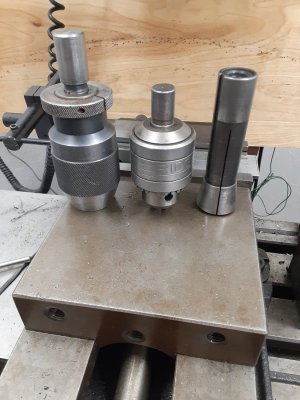I know that this is gonna be a use specific question but pass some knowledge on to a newbie. I have been slowing cleaning, lubing and general maintenance stuff on a few Jacob's drill chucks. I have a 2MT drill press (which is worth noting but not a big variable) the tailstock of my lathe is 2MT, and my Mill uses R8. I have a couple of nice #34 chucks each with a 2MT arbor. Then I have 2 14N, a 16N and a soon to arrive 18N Super chucks. These are in addition to a keyless Chuck for both the mill and the drill press. The drill press being an Amazon special and the mill being a nicer albeit Chinese R8 unit. The question is, what type of arbor would serve me best. Having 2 of the 14N’s I plan for one 2MT and one R8. For the 16N and 18N would I be better served doing 2MT and then getting an R8 to 2MT sleeve or should go with R8? My lathe is a 10x24 hobby lathe so I do believe it will handle a big 3/4 shank drill bit. Also on in opposition to that my mill is an 8x30 knee mill and spindle to table height is a limitation. Would I gain anything by using a straight shank and a collet? That would make them unusable in the lathe. Would it be better to do the 2MT? Would that cause additional problems with the mill?
I literally have zero experience in machining. It seemed intriguing so I am running down the rabbit hole and trying to learn as much as I can. I say this because I have no prior experience, notions, or prejudices to steer me any one direction and I am not obviously making high tolerance items. I just want to squeeze the best performance to capability balance out of what I have.
I literally have zero experience in machining. It seemed intriguing so I am running down the rabbit hole and trying to learn as much as I can. I say this because I have no prior experience, notions, or prejudices to steer me any one direction and I am not obviously making high tolerance items. I just want to squeeze the best performance to capability balance out of what I have.


